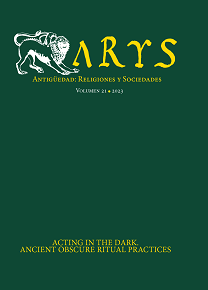Día y noche, luz y oscuridad en las Bacantes de Eurípides
DOI:
https://doi.org/10.20318/arys.2023.7511Palabras clave:
armonía, Bacantes, día, Dioniso, Eurípides, interpretación, luz, noche, oscuridad, Penteo, sacrificioResumen
En mi artículo sigo el tema de la luz y la oscuridad en las Bacantes de Eurípides. La luz y la oscuridad son uno de los muchos hilos de significado de las Bacantes. Va de la mano de la interpretación general de la obra. La luz y la oscuridad están presentes en las caracterizaciones de Dioniso y Penteo. Más que eso, las caracterizaciones a través de la luz y la oscuridad cambian de acuerdo con la historia de la obra. Una lectura atenta de las Bacantes en términos de luz y oscuridad puede, por tanto, ayudar a determinar qué evaluaciones de Penteo y Dioniso están inscritas en la obra. El drama de la luz y la oscuridad sugiere una interpretación del sparagmos como sacrificio expiatorio y de la restauración de la armonía al final de la obra.
Descargas
Referencias
Aguirre, Mercedes (2010). Erinyes as Creatures of Darkness. In Christopoulos, Karakantza & Levaniouk, 2010, pp. 133-141.
Barzini, Luigi (2021). Mystery Cults, Theatre and Athenian Politics. A Reading of Euripides’ Bacchae and Aristophanes’ Frogs. London: Bloomsbury.
Burkert, Walter & Marinatos, Nannos (2010). Introduction. In Christopoulos, Karakantza & Levaniouk, 2010, pp. XV-XX.
Buxton, Richard (1989). The Messenger and the Maenads. A Speech from Euripides’ Bacchae (1043-1152). Acta Antiqua Academiae Scientiarum Hungaricae, 32, pp. 225-234.
Buxton, Richard (2009). Feminized Males in Bacchae. The Importance of Discrimination. In Goldhill & Hall, 2009, pp. 232-250.
Christopoulos, Menelaos, Karakantza, Efimia D. & Levaniouk, Olga (eds.) (2010). Light and Darkness in Ancient Greek Myth and Religion. Greek Studies: Interdisciplinary Approaches. Lanham: Lexington Books.
Diggle, James (1994). Euripidis fabulae / 3: Helena, Phoenissae, Orestes, Bacchae, Iphigenia Aulidensis, Rhesus. Oxford: Clarendon Press.
Diller, Hans (1971). Kleine Schriften zur antiken Literatur. München: C.H. Beck.
Dodds, Eric R. (1929). Euripides the Irrationalist. Classical Review, 43, pp. 97-104.
Dodds, Eric R. (1944). Bacchae. Oxford: Clarendon Press.
Doroszewski, Filip & Karłowicz, Dariusz (eds.) (2021). Dionysus and Politics. Constructing Authority in the Graeco-Roman World. London: Routledge.
Foley, Helene P. (1985). Ritual Irony, Poetry and Sacrifice in Euripides. Ithaca: Cornell University Press.
Friedrich, Enno (2022). “Green Vines on the Slag of Ruin”? The Choir in Euripides’ Bacchae. Sapiens Ubique Civis, 3, pp. 87-110.
Garvie, Alex (2016). Paradoxes and Themes in Bacchae. In Stuttard, 2016, pp. 109-120.
Girard, René (1988) [1972]. Violence and the Sacred. Translated by Patrick Gregory. London: Continuum.
Goldhill, Simon (1986). Reading Greek Tragedy. Cambridge: Cambridge University Press.
Goldhill, Simon & Hall, Edith (eds.) (2009). Sophocles and the Greek Tragic Tradition. Cambridge: Cambridge University Press.
Grube, George M.A. (1935). Dionysus in the Bacchae. Transactions and Proceedings of the American Philological Association, 66, pp. 37-54.
Hall, Edith (2016). Perspectives on the Impact of Bacchae at its Original Performance. In Stuttard, 2016, pp. 11-28.
Hose, Martin (1991). Studien zum Chor bei Euripides, II. Stuttgart: Teubner.
Karamanou, Ioanna (2016). Family Reunion or Household Disaster? Exploring Plot Diversity in Euripides’ Last Production. In Stuttard, 2016, pp. 43-57.
Kirk, Geoffrey S. (1979). The Bacchae of Euripides. Cambridge: Cambridge University Press.
Kitto, Humphrey D.F. (1939). Greek Tragedy. A Literary Study. London: Methuen.
Kyriakou, Poulheria & Rengakos, Antonios (eds.) (2016). Wisdom and Folly in Euripides. Berlin: De Gruyter.
Leinieks, Valdis (1996). The City of Dionysos. Stuttgart: Teubner.
Létoublon, Françoise (2010). Blind People and Blindness in Ancient Greek Myths. In Christopoulos, Karakantza & Levaniouk, 2010, pp. 167-180.
McClure, Laura (ed.) (2017). A Companion to Euripides. Chichester: Wiley Blackwell.
Mills, Sophie (2006). Euripides, Bacchae. London: Duckworth.
Morgan, Kathryn A. (ed.) (2003). Popular Tyranny. Sovereignty and Its Discontents in Ancient Greece. Austin: University of Texas Press.
Norwood, Gilbert (1908). The Riddle of the Bacchae. The Last Stage of Euripides. Manchester: University of Manchester Press.
Oranje, Hans (1984). Euripides’ Bacchae. The Play and Its Audience. Leiden: Brill.
Paleothodoros, Dimitris (2010). Light and Darkness in Dionysiac Rituals as Illustrated on Attic Vase Paintings of the 5th Century BCE. In Christopoulos, Karakantza & Levaniouk, 2010, pp. 237-260.
Pohlenz, Max (1954). Die griechische Tragödie. Göttingen: Vandenhoeck und Ruprecht.
Reitzammer, Laurialan (2017). Bacchae. In McClure, 2017, pp. 298-311.
Rivier, André (1975). Essai sur le tragique d’Euripide. Paris: Boccard.
Roux, Jeanne (1972). Les Bacchantes, II: Commentaire. Paris: Les Belles Lettres.
Scott, William C. (1975). Two Suns over Thebes. Imagery and Stage Effects in the Bacchae. Transactions and Proceedings of the American Philological Association, 105, pp. 333-346.
Seaford, Richard (1996). Bacchae. With an Introduction, Translation and Commentary. Warminster: Aris & Phillips.
Seaford, Richard (2003). Tragic Tyranny. In Morgan, 2003, pp. 95-116.
Seaford, Richard (2010). Mystic Light and Near-Death Experience. In Christopoulos, Karakantza & Levaniouk, 2010, pp. 201-206.
Seaford, Richard (2021). The Politics of Euripides’ Bacchae and the Preconception of Irresolvable Contradiction. In Doroszewski & Karłowicz, 2021, pp. 18-31.
Seidensticker, Bernd (2016). The Figure of Teiresias in Euripides’ Bacchae. In Kyriakou & Rengakos, 2016, pp. 275-283.
Segal, Charles (1986). Interpreting Greek Tragedy. Myth, Poetry, Text. Ithaca: Cornell University Press.
Soyinka, Wole (1973). The Bacchae of Euripides. A Communion Rite. New York: Norton & Company.
Stuttard, David (ed.) (2016). Looking at Bacchae. London: Bloomsbury.
Verdenius, Willem J. (1988). Cadmus, Teiresias, Pentheus. Notes on Euripides’ Bacchae 170- 369. Mnemosyne, 41, pp. 241-268.
Verrall, Arthur (1910). The Bacchants of Euripides and other Essays. Cambridge: Cambridge University Press.
Winnington-Ingram, Reginald P. (1948). Euripides and Dionysus. An interpretation of the Bacchae. Cambridge: Cambridge University Press.
Descargas
Publicado
Número
Sección
Licencia
Los autores conservan los derechos de autor de sus textos y todos los derechos de publicación sin restricciones.
Los documentos incluyen desde 2021 la licencia Creative Commons 4.0: Atribución–No Comercial–Sin Obra Derivada (CC BY-NC-ND 4.0). Los documentos anteriores incluyen la licencia Creative Commons 3.0: Atribución-No Comercial-Sin Obra Derivada (CC BY-NC-ND 3.0)
